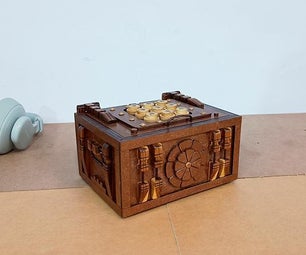Introduction: Litter Box Poop Detector
Intro:
Digging through the litter box in search of the brown gold is not something I enjoy. And you don't want to go through the box, stiring up a cloud of dust, unless you're sure you're going to find something. That's why I constructed this little device.
Function:
Push the button and the red light lights up if the cat has been in the box, if it hasn't the green light lights up.
Flip the on/off swith to reset the light to green when you have cleaned the box.
Digging through the litter box in search of the brown gold is not something I enjoy. And you don't want to go through the box, stiring up a cloud of dust, unless you're sure you're going to find something. That's why I constructed this little device.
Function:
Push the button and the red light lights up if the cat has been in the box, if it hasn't the green light lights up.
Flip the on/off swith to reset the light to green when you have cleaned the box.
Step 1: What You Need
To build this I used:
Red diode
Green diode
Small push-button
Small flip-switch
9V battery + connector
Magnetic contact switch
One 4xNAND logic DIL IC (of which 2 is used)
10 kOhm resistor
10 MOhm resistor
Some small wires
Circuit board
Small plastic box for housing it all
Tools needed:
Multimeter
Lab circuit board
Drill
Wire cutter
Soldering station
Liquid glue gun
Red diode
Green diode
Small push-button
Small flip-switch
9V battery + connector
Magnetic contact switch
One 4xNAND logic DIL IC (of which 2 is used)
10 kOhm resistor
10 MOhm resistor
Some small wires
Circuit board
Small plastic box for housing it all
Tools needed:
Multimeter
Lab circuit board
Drill
Wire cutter
Soldering station
Liquid glue gun
Step 2: A Simple Circuit
The circuit:
We use two of the NAND gates in the IC to create a latch; a simple memory that will remember if the s1 switch has been opened or not.
We want as small as possible current so that the battery will last as long as possible. That is why we have the pushbutton switch, s2. If you connect the device to a power outlet you can skip the switch, in that way you do not have to go to the box and push the button to see the status. With a 10 kOhm resistor the LEDs I used barely light up.
The 10 MOhm resistor is used as pull-down so that the input to the IC is not left 'floating'.
Testing the solution:
It's a good idea to connect everything on a lab board to test the solution before soldering.
Possible improvements:
The curcuit could be constructed to draw even less current if a relay was used between the diods and the IC. Then the IC would draw a really small current to hold the latch and then switch on a larger current when the check button, s2, is pushed.
We use two of the NAND gates in the IC to create a latch; a simple memory that will remember if the s1 switch has been opened or not.
We want as small as possible current so that the battery will last as long as possible. That is why we have the pushbutton switch, s2. If you connect the device to a power outlet you can skip the switch, in that way you do not have to go to the box and push the button to see the status. With a 10 kOhm resistor the LEDs I used barely light up.
The 10 MOhm resistor is used as pull-down so that the input to the IC is not left 'floating'.
Testing the solution:
It's a good idea to connect everything on a lab board to test the solution before soldering.
Possible improvements:
The curcuit could be constructed to draw even less current if a relay was used between the diods and the IC. Then the IC would draw a really small current to hold the latch and then switch on a larger current when the check button, s2, is pushed.
Step 3: Soldering
Soldering:
Solder everything in palce on a lab circuit board. Be sure to use heat shrink tubing to protect exposed wires.
Solder everything in palce on a lab circuit board. Be sure to use heat shrink tubing to protect exposed wires.
Step 4: Cramming It Into the Box
Housing:
Drill some holes in the plastic box for the switches, wires and LEDs.
My box was a little bit too small so I had to put the battery in sideways. Be sure to put tape on the battery so that it doesn't short circuit something by accident.
I used a box with screws so that I can open the box again to change battery. According to my calculations I'll have to change battery about once a month.
Drill some holes in the plastic box for the switches, wires and LEDs.
My box was a little bit too small so I had to put the battery in sideways. Be sure to put tape on the battery so that it doesn't short circuit something by accident.
I used a box with screws so that I can open the box again to change battery. According to my calculations I'll have to change battery about once a month.
Step 5: Mounting
Mount the device:
The magnetic switch is to be mounted so that the current is cut when the litter box door is opened.
I used a liquid glue gun to attach the switch and wiring on the inside of the litter box and the electronics box on the outside with the lid facing outwards for easy re-opening.
The magnetic switch is to be mounted so that the current is cut when the litter box door is opened.
I used a liquid glue gun to attach the switch and wiring on the inside of the litter box and the electronics box on the outside with the lid facing outwards for easy re-opening.

Participated in the
Pet Contest







